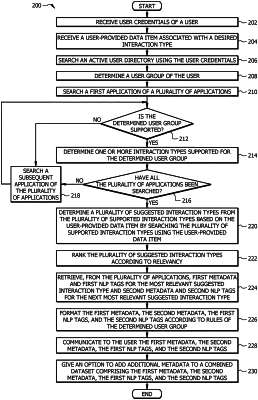| CPC G06F 16/90335 (2019.01) [H04L 63/08 (2013.01)] | 20 Claims |

|
1. An apparatus comprising:
a memory storing a machine learning algorithm; and
a processor communicatively coupled to the memory, wherein the processor, when implementing the machine learning algorithm, is configured to:
receive user credentials of a user;
receive, from the user, a user-provided data item associated with a desired interaction type of the user, wherein an implementation of the desired interaction type is unknown to the user;
determine a user group of the user based on the user credentials;
search at least a first application in a plurality of applications to determine whether the determined user group is supported by the first application by comparing the determined user group with one or more first user groups supported by the first application;
in response to determining that the determined user group matches the one or more first user groups supported by the first application, determine one or more first interaction types that are supported by the first application for the determined user group, wherein the first application stores the one or more first interaction types along with first metadata and first NLP tags associated with the one or more first interaction types;
search a subsequent application in the plurality of applications to determine whether the determined user group is supported by the subsequent application by comparing the determined user group with one or more subsequent user groups supported by the subsequent application;
in response to determining that the determined user group matches the one or more subsequent user groups supported by the subsequent application, determine one or more subsequent interaction types that are supported by the subsequent application for the determined user group, wherein the subsequent application stores the one or more subsequent interaction types along with second metadata and second NLP tags associated with the one or more subsequent interaction types;
determine a plurality of suggested interaction types from the plurality of supported interaction types based on the user-provided data item, wherein the plurality of suggested interaction types are ranked according to relevancy;
retrieve, from the plurality of applications, the first metadata and the first NLP tags for the most relevant suggested interaction type and the second metadata and the second NLP tags for the next most relevant suggested interaction type;
format the first metadata, the second metadata, the first NLP tags, and the second NLP tags according to rules of the determined user group; and
communicate to the user the first metadata, the second metadata, the first NLP tags, and the second NLP tags.
|